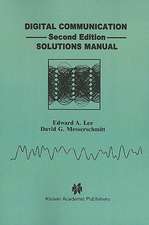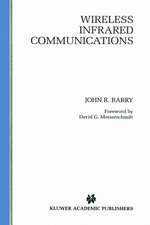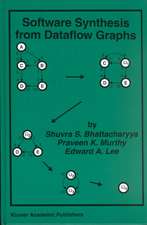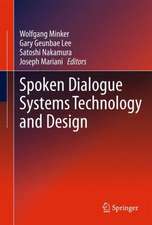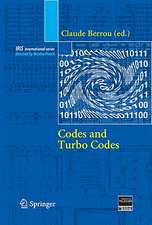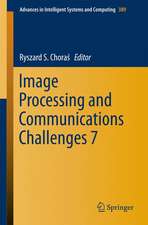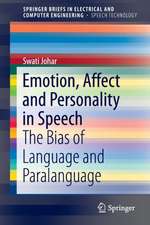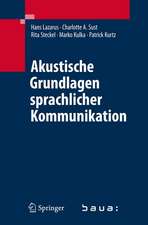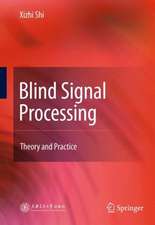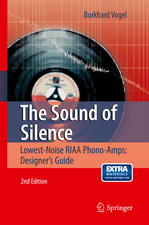Digital Communication
Autor John R. Barry, Edward A. Lee, David G. Messerschmitten Limba Engleză Hardback – 30 sep 2003
| Toate formatele și edițiile | Preț | Express |
|---|---|---|
| Paperback (1) | 666.77 lei 38-44 zile | |
| Springer Us – 6 noi 2012 | 666.77 lei 38-44 zile | |
| Hardback (1) | 1041.88 lei 43-57 zile | |
| Springer Us – 30 sep 2003 | 1041.88 lei 43-57 zile |
Preț: 1041.88 lei
Preț vechi: 1270.59 lei
-18% Nou
Puncte Express: 1563
Preț estimativ în valută:
199.36€ • 208.71$ • 164.96£
199.36€ • 208.71$ • 164.96£
Carte tipărită la comandă
Livrare economică 07-21 aprilie
Preluare comenzi: 021 569.72.76
Specificații
ISBN-13: 9780792375487
ISBN-10: 0792375483
Pagini: 838
Ilustrații: XVII, 838 p.
Dimensiuni: 178 x 254 x 44 mm
Greutate: 1.65 kg
Ediția:3rd ed. 2004
Editura: Springer Us
Colecția Springer
Locul publicării:New York, NY, United States
ISBN-10: 0792375483
Pagini: 838
Ilustrații: XVII, 838 p.
Dimensiuni: 178 x 254 x 44 mm
Greutate: 1.65 kg
Ediția:3rd ed. 2004
Editura: Springer Us
Colecția Springer
Locul publicării:New York, NY, United States
Public țintă
Professional/practitionerCuprins
1. Introduction.- 2. Deterministic Signal Processing.- 3. Stochastic Signal Processing.- 4. Limits of Communication.- 5. Pulse-Amplitude Modulation.- 6. Advanced Modulation.- 7. Probabilistic Detection.- 8. Equalization.- 9. Adaptive Equalization.- 10. MIMO Communications.- 11. Fading and Diversity.- 12. Error Control.- 13. Signal-Space Coding.- 14. Phase-Locked Loops.- 15. Carrier Recovery.- 16. Timing Recovery.- 17. Multiple Access Alternatives.- Exercise Solutions.
Textul de pe ultima copertă
This book is for designers and would-be designers of digital communication systems. The general approach of this book is to extract the common principles underlying a range of media and applications and present them in a unified framework. Digital Communication is relevant to the design of a variety of systems, including voice and video digital cellular telephone, digital CATV distribution, wireless LANs, digital subscriber loop, metallic Ethernet, voiceband data modems, and satellite communication systems.
New in this Third Edition:
New material on recent advances in wireless communications, error-control coding, and multi-user communications has been added. As a result, two new chapters have been added, one on the theory of MIMO channels, and the other on diversity techniques for mitigating fading.
Error-control coding has been rewritten to reflect the current state of the art.
Chapters 6 through 9 from the Second Edition have been reorganized and streamlined to highlight pulse-amplitude modulation, becoming the new Chapters 5 through 7.
Readability is increased by relegating many of the more detailed derivations to appendices and exercise solutions, both of which are included in the book.
Exercises, problems, and solutions have been revised and expanded.
Three chapters from the previous edition have been moved to the book’s Web site to make room for new material.
This book is ideal as a first-year graduate textbook, and is essential to many industry professionals. The book is attractive to both audiences through the inclusion of many practical examples and a practical flavor in the choice of topics.
Digital Communication has a Web site at : http://www.ece.gatech.edu/~barry/digital/, where the reader may find additional information from the Second Edition, other supplementary materials, useful links, a problem solutions manual, and errata.
New in this Third Edition:
New material on recent advances in wireless communications, error-control coding, and multi-user communications has been added. As a result, two new chapters have been added, one on the theory of MIMO channels, and the other on diversity techniques for mitigating fading.
Error-control coding has been rewritten to reflect the current state of the art.
Chapters 6 through 9 from the Second Edition have been reorganized and streamlined to highlight pulse-amplitude modulation, becoming the new Chapters 5 through 7.
Readability is increased by relegating many of the more detailed derivations to appendices and exercise solutions, both of which are included in the book.
Exercises, problems, and solutions have been revised and expanded.
Three chapters from the previous edition have been moved to the book’s Web site to make room for new material.
This book is ideal as a first-year graduate textbook, and is essential to many industry professionals. The book is attractive to both audiences through the inclusion of many practical examples and a practical flavor in the choice of topics.
Digital Communication has a Web site at : http://www.ece.gatech.edu/~barry/digital/, where the reader may find additional information from the Second Edition, other supplementary materials, useful links, a problem solutions manual, and errata.
Caracteristici
Request lecturer material: sn.pub/lecturer-material

